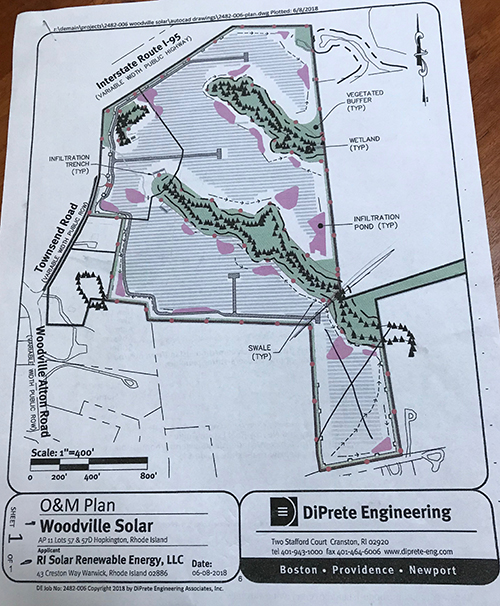By TIM FAULKNER/ecoRI
News staff
 Public
discontent with large solar arrays and commercial construction is intensifying
as developers increase proposals for projects on large tracts of open space.
Public
discontent with large solar arrays and commercial construction is intensifying
as developers increase proposals for projects on large tracts of open space.
As homemade yard signs
declared outside the Aug. 6 Town Council meeting at Chariho Middle School, residents
want town officials to “Keep Hopkinton Country.”
“Leave this residential
property site alone and don’t jeopardize our heath and our children’s health,”
Old Depot Road resident Joseph Moreau told the Town Council, referring to a
13.8-megawatt Rhode Island Solar Renewable Energy
III LLC solar project.
For 40 minutes Moreau
flipped through a large binder of notes, telling the council of his objections
to this project and others requiring zoning exemptions.
Moreau chastised the
Town Council for being enticed by meager tax revenue instead of adhering to the
town's comprehensive plan that emphasizes preserving open space and farmland.
“Again, it’s about the
almighty dollar,” he said.
Moreau and most of the 160 residents in attendance didn't like that the Town Council previously voted against the recommendation of the Planning Board to approve a 15-megawatt, 68-acre solar facility at 310 Main St.
The council also approved an 18.8-megawatt, 60-acre project on Alton Bradford Road, a project that received a 2-2 vote from the Planning Board.
To date, the town has
approved 12 large-scale solar projects and opponents fear that the five-member
council will once again defy Planning Boards opposition, this time to approve
the Rhode Island Solar Renewable Energy III project and the larger Brushy Brook
solar project.
Seven new solar projects await review by the Planning Board, five of which require zoning changes.
Seven new solar projects await review by the Planning Board, five of which require zoning changes.
Attorney Jim Donnelly,
representing the opposition group Hopkinton Citizens for Responsible
Planning, raised the issue that town regulations require at least a
4-1 supermajority vote for the Town Council to override an adverse
recommendation by the Planning Board.
Residents said these
projects are being built too close to homes, thereby decreasing property
values.
They also claim that solar development increases harmful runoff and the potential contamination of groundwater from herbicides and toxic chemicals from the solar panels.
They noted that Hopkinton sits on one primary aquifer that supplies the majority of water to the community.
They also claim that solar development increases harmful runoff and the potential contamination of groundwater from herbicides and toxic chemicals from the solar panels.
They noted that Hopkinton sits on one primary aquifer that supplies the majority of water to the community.
In an Aug. 10 letter to town officials,
resident Eric Bibler said opponents “see erosion and environmental degradation;
an alarming avoidance and transgression of the town's time-honored planning
mechanisms; and the sacrifice of the town's rural character that has been
Hopkinton's true identity for hundreds of years; these Town Councilors see only
tax revenue.”
Bibler joined Hopkinton
Citizens for Responsible Planning, which was founded the day of the Town
Council hearing. So far, the group has 38 members.
“I am nervous that
the Planning Board could be right, and that an obdurate handful of three
misguided Town Councilors might be wrong about whether something could go badly
awry here in Hopkinton after these large-scale projects are all installed,”
Bibler said.
In the e-mail he sent to
council members that includes his letter, Bibler submitted a photo and videos
of erosion and runoff caused by clearing-cutting for a solar facility in
Spotsylvania County, Va. The photo and video were taken by a resident living
near the project.
At the Aug. 6 meeting,
engineers for the developer, Anthony DelVicario of Warwick, responded to public
criticism by offering to move the project back 700 feet from one of the roads.
The alteration also eliminated two stormwater retention areas and reduced the
electricity generating capacity by 2 megawatts.
The developer also
revealed that the town is partially responsible for paying to clean and cap a
portion of the project site that was once a municipal dump.
According to Rhode
Island Department of Environmental Management regulations, the current owner, previous
owners, or anyone who has dumped on the property, such as the town, are responsible
for the cleanup.
The Town Council said it
will address these developments and likely vote on the projects at its Sept. 4
meeting.
Renewable-energy siting
issues will be discussed at a public workshop on siting guidelines led
by the Office of Energy Resources at Richmond Town Hall, 5 Richmond Townhouse
Road, scheduled for Aug. 27 from 6:30-8 p.m.
The Town Council also
agreed to postpone hearings for the proposed Brushy Brook solar farm until
after the election in November.